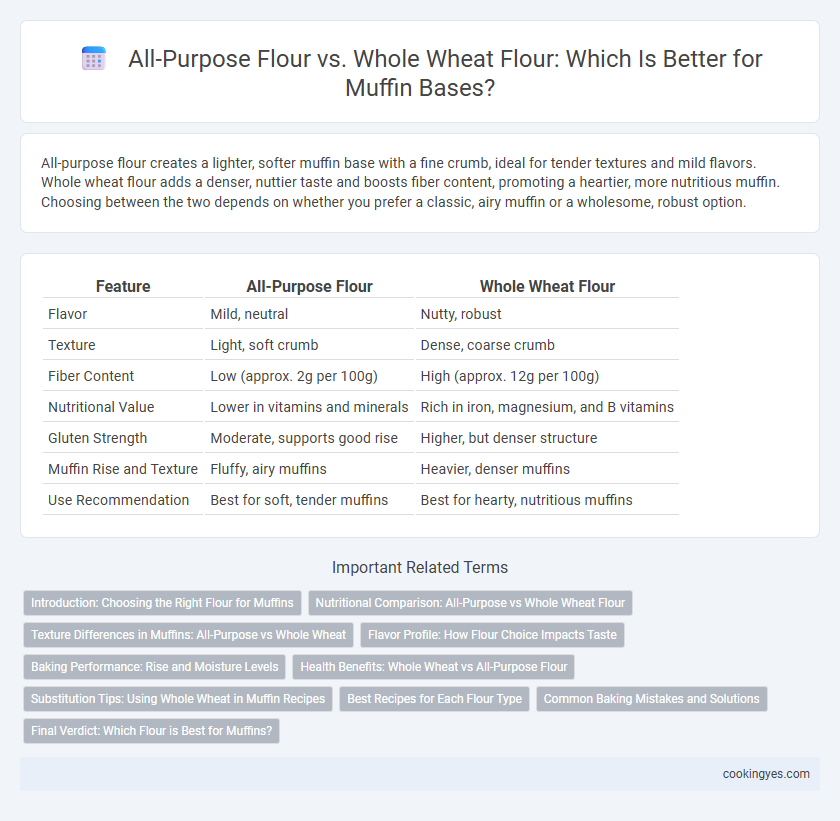All-purpose flour creates a lighter, softer muffin base with a fine crumb, ideal for tender textures and mild flavors. Whole wheat flour adds a denser, nuttier taste and boosts fiber content, promoting a heartier, more nutritious muffin. Choosing between the two depends on whether you prefer a classic, airy muffin or a wholesome, robust option.
Table of Comparison
| Feature | All-Purpose Flour | Whole Wheat Flour |
|---|---|---|
| Flavor | Mild, neutral | Nutty, robust |
| Texture | Light, soft crumb | Dense, coarse crumb |
| Fiber Content | Low (approx. 2g per 100g) | High (approx. 12g per 100g) |
| Nutritional Value | Lower in vitamins and minerals | Rich in iron, magnesium, and B vitamins |
| Gluten Strength | Moderate, supports good rise | Higher, but denser structure |
| Muffin Rise and Texture | Fluffy, airy muffins | Heavier, denser muffins |
| Use Recommendation | Best for soft, tender muffins | Best for hearty, nutritious muffins |
Introduction: Choosing the Right Flour for Muffins
All-purpose flour provides a light, tender crumb ideal for classic muffins, while whole wheat flour offers a denser texture and richer flavor due to its higher fiber and nutrient content. Muffin recipes using whole wheat flour benefit from its natural nuttiness and enhanced nutritional profile, including increased protein and vitamins. Balancing the flour choice depends on desired muffin texture, taste, and health considerations.
Nutritional Comparison: All-Purpose vs Whole Wheat Flour
Whole wheat flour contains more fiber, vitamins, and minerals compared to all-purpose flour, making it a healthier choice for muffin bases. All-purpose flour is refined and lower in nutrients but provides a lighter texture and softer crumb. Choosing whole wheat flour enhances muffins with increased protein and antioxidants while offering a denser, heartier consistency.
Texture Differences in Muffins: All-Purpose vs Whole Wheat
All-purpose flour produces muffins with a lighter, softer, and more tender crumb due to its moderate protein content, which forms a balanced gluten network. Whole wheat flour results in denser, coarser-textured muffins with a heartier, nuttier flavor because of the bran and germ present, which interfere with gluten development. Choosing all-purpose flour yields a fluffier muffin, while whole wheat offers a more substantial and chewy bite ideal for fiber-rich recipes.
Flavor Profile: How Flour Choice Impacts Taste
All-purpose flour creates muffins with a neutral, light crumb that highlights other flavors, producing a tender texture and subtle sweetness. Whole wheat flour imparts a nuttier, earthier taste with a denser crumb, contributing richer flavor complexity and heartiness. The choice between these flours significantly shapes the muffin's overall flavor profile, balancing mildness against robust, wholesome notes.
Baking Performance: Rise and Moisture Levels
All-purpose flour creates muffins with a lighter rise and softer crumb due to its moderate protein content, which allows better gluten development and gas retention during baking. Whole wheat flour results in denser muffins with a heartier texture because its bran and germ interfere with gluten formation and absorb more moisture, reducing overall rise. Using a blend of both flours can balance moisture retention and achieve optimal rise for tender, moist muffins.
Health Benefits: Whole Wheat vs All-Purpose Flour
Whole wheat flour offers higher fiber content, vitamins, and minerals compared to all-purpose flour, making muffins more nutritious and beneficial for digestive health. The presence of bran and germ in whole wheat flour contributes to better blood sugar regulation and sustained energy release. Using whole wheat flour as a muffin base supports heart health and weight management due to its lower glycemic index and increased nutrient density.
Substitution Tips: Using Whole Wheat in Muffin Recipes
Whole wheat flour can replace all-purpose flour in muffin recipes for added fiber and nutrients, but it may result in a denser texture. To maintain moisture and lightness, substitute no more than 50% of the all-purpose flour with whole wheat flour and consider adding an extra egg or a bit of yogurt. Allow the batter to rest for 10-15 minutes before baking to improve hydration and softness in the final muffins.
Best Recipes for Each Flour Type
All-purpose flour creates tender, light muffins with a fine crumb, ideal for classic blueberry or chocolate chip recipes that emphasize soft texture and subtle flavor. Whole wheat flour lends a denser, heartier muffin with added fiber and nutrients, perfect for recipes featuring nuts, fruits, or spices to complement its robust, earthy taste. Adjusting liquid ingredients or adding a bit of baking powder can optimize rise and moisture depending on the flour choice, ensuring the best baking results.
Common Baking Mistakes and Solutions
Using all-purpose flour in muffins often leads to a lighter texture but can cause overmixing, resulting in dense muffins due to gluten overdevelopment. Whole wheat flour adds fiber and nutrients but tends to absorb more liquid, making muffins dry if moisture isn't adjusted properly. To avoid common mistakes, substitute no more than half of the all-purpose flour with whole wheat flour and increase liquid ingredients slightly to maintain tenderness and moisture balance.
Final Verdict: Which Flour is Best for Muffins?
All-purpose flour produces muffins with a lighter, softer crumb and a more neutral flavor, making it ideal for classic, tender muffins. Whole wheat flour offers a denser texture and richer, nuttier taste, along with added fiber and nutrients, perfect for healthier, hearty muffins. For the best balance between texture and nutrition, a blend of all-purpose and whole wheat flour is often recommended for muffins.
All-purpose flour vs Whole wheat flour for muffin base Infographic

 cookingyes.com
cookingyes.com